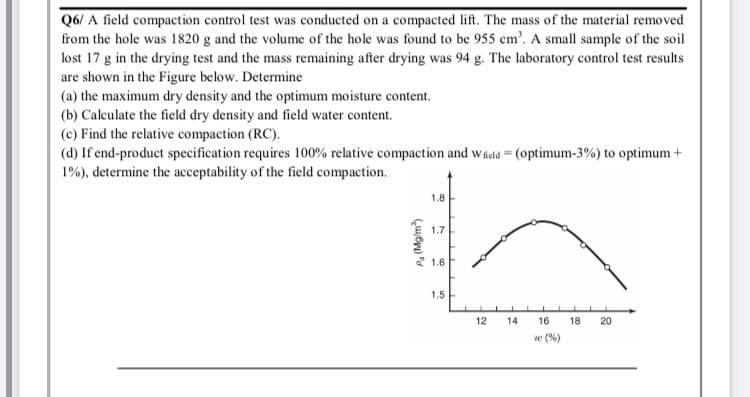Q6/ A field compaction control test was conducted on a compacted lift. The mass of the material removed from the hole was 1820 g and the volume of the hole was found to be 955 cm'. A small sample of the soil lost 17 g in the drying test and the mass remaining after drying was 94 g. The laboratory control test results are shown in the Figure below. Determine (a) the maximum dry density and the optimum moisture content. (b) Calculate the field dry density and field water content. (c) Find the relative compaction (RC). (d) If end-product specification requires 100% relative compaction and wadd (optimum-3%) to optimum + 1%), determine the acceptability of the field compaction.
Q6/ A field compaction control test was conducted on a compacted lift. The mass of the material removed from the hole was 1820 g and the volume of the hole was found to be 955 cm'. A small sample of the soil lost 17 g in the drying test and the mass remaining after drying was 94 g. The laboratory control test results are shown in the Figure below. Determine (a) the maximum dry density and the optimum moisture content. (b) Calculate the field dry density and field water content. (c) Find the relative compaction (RC). (d) If end-product specification requires 100% relative compaction and wadd (optimum-3%) to optimum + 1%), determine the acceptability of the field compaction.
Fundamentals of Geotechnical Engineering (MindTap Course List)
5th Edition
ISBN:9781305635180
Author:Braja M. Das, Nagaratnam Sivakugan
Publisher:Braja M. Das, Nagaratnam Sivakugan
Chapter5: Soil Compaction
Section: Chapter Questions
Problem 5.17CTP
Related questions
Question

Transcribed Image Text:Q6/ A field compaction control test was conducted on a compacted lift. The mass of the material removed
from the hole was 1820 g and the volume of the hole was found to be 955 cm'. A small sample of the soil
lost 17 g in the drying test and the mass remaining after drying was 94 g. The laboratory control test results
are shown in the Figure below. Determine
(a) the maximum dry density and the optimum moisture content.
(b) Calculate the field dry density and field water content.
(c) Find the relative compaction (RC).
(d) If end-product specification requires 100% relative compaction and wield = (optimum-3%) to optimum +
1%), determine the acceptability of the field compaction.
1.8
1.7
* 1.6
1.5
12
14
16
18
20
w (%)
Expert Solution
This question has been solved!
Explore an expertly crafted, step-by-step solution for a thorough understanding of key concepts.
This is a popular solution!
Trending now
This is a popular solution!
Step by step
Solved in 6 steps with 1 images

Knowledge Booster
Learn more about
Need a deep-dive on the concept behind this application? Look no further. Learn more about this topic, civil-engineering and related others by exploring similar questions and additional content below.Recommended textbooks for you

Fundamentals of Geotechnical Engineering (MindTap…
Civil Engineering
ISBN:
9781305635180
Author:
Braja M. Das, Nagaratnam Sivakugan
Publisher:
Cengage Learning

Principles of Geotechnical Engineering (MindTap C…
Civil Engineering
ISBN:
9781305970939
Author:
Braja M. Das, Khaled Sobhan
Publisher:
Cengage Learning

Fundamentals of Geotechnical Engineering (MindTap…
Civil Engineering
ISBN:
9781305635180
Author:
Braja M. Das, Nagaratnam Sivakugan
Publisher:
Cengage Learning

Principles of Geotechnical Engineering (MindTap C…
Civil Engineering
ISBN:
9781305970939
Author:
Braja M. Das, Khaled Sobhan
Publisher:
Cengage Learning